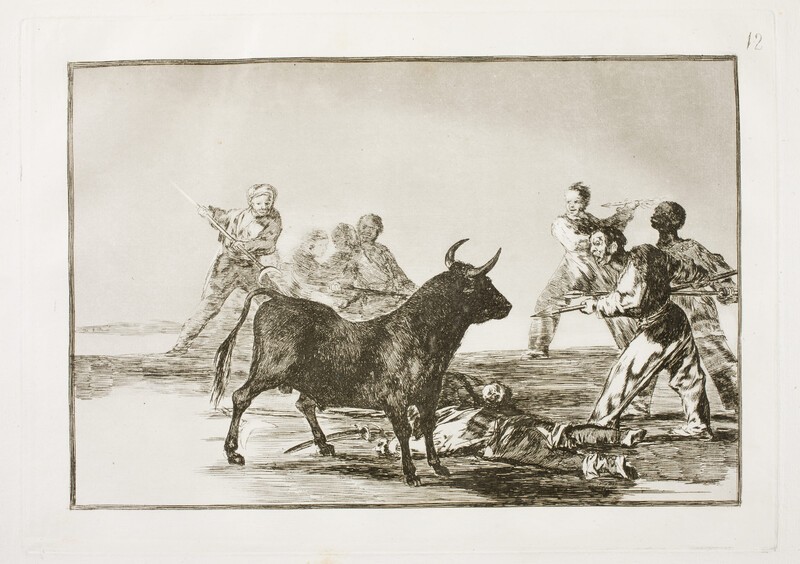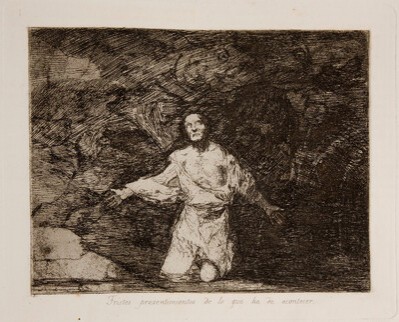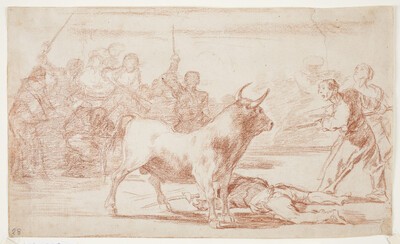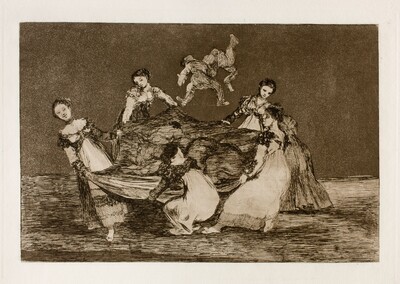- Cronología
- 1814 - 1816
- Dimensiones
- 251 x 353 mm
- Técnica y soporte
- Aguafuerte, aguatinta, punta seca y bruñidor
- Reconocimiento de la autoría de Goya
- Documented work
- Ficha: realización/revisión
- 01 Oct 2021 / 22 Jun 2023
- Inventario
- -
12 (print, upper right-hand corner)
See How the ancient Spaniards hunted bulls on horseback in the countryside
There is a state proof of this same print that Goya made before numbering the plate and applying the aquatint.
The plate is kept at the National Chalcography (nº 345).
See How the ancient Spaniards hunted bulls on horseback in the countryside
Several figures are harassing a bull with spears and other sharp instruments, which is crouched and looking at them in the centre of the composition. The bodies of two men lie on the ground, probably because they have been run over by the bull. There are no elements to help us locate the scene in any particular place.
It represents a cruel practice, inspired by the custom of finishing off the bull at the hands of popular gangs in exchange for a modest stipend. If the bull did not die soon or was in poor condition, it was left to these groups, made up of all kinds of low-life individuals, who finished it off in the bullring.
Lafuente Ferrari related the print to the Disasters of War and the Absurdities because of the harshness of the scene, the faces of some of the figures, which resemble those of other individuals depicted in those series, and the way they surround the bull, reminiscent of the attitude of the aggressive crowds in both series.He also compares the engraving with the preparatory drawing for it, also entitled Disembowelment of the rogue with spears, crescent moons, banderillas and other weapons, detecting certain differences between the two. The main difference is that in the engraving the number of figures in the background of the drawing was reduced, although the two individuals lying on the ground and the black figure were added. Glendinning, for his part, relates this print to the depiction of human barbarism.
The work is remarkable for the successful contrast between the dignity of the bull and the lowliness of the members of the gang who are trying to kill it. The way in which Goya presents the figures in the background, more blurred, enhances the perspective of the engraving.
-
Grabados y dibujos de Goya en la Biblioteca NacionalBiblioteca NacionalMadrid1946catalogue Elena Páez Ríos
-
Goya en la Biblioteca Nacional. Exposición de grabados y dibujos en el sesquicentenario de su muerteBiblioteca NacionalMadrid1978May - June 1978
-
1984
-
Madrid1987
-
Madrid1990
-
Goya grabadorFundación Juan MarchMadrid1994consultant editors Alfonso E. Pérez Sánchez and Julián Gállego, from January 14th to March 20th 1994
-
Goya grabadorMuseo del Grabado Español ContemporáneoMarbella1996from March 8th to May 5th 1996
-
Zaragoza1996
-
Ydioma universal: Goya en la Biblioteca NacionalBiblioteca NacionalMadrid1996from September 19th to December 15th 1996cat. 283
-
Schlaf der Vernunft. Original radierungen von Francisco de GoyaMunich2000
-
Madrid2002
-
Madrid2002
-
Goya en tiempos de guerraMuseo Nacional del PradoMadrid2008consultant editor Manuela B. Mena Marqués, from April 14th to July 13th 2008cat. 146
-
Bilbao2012
-
Goya luces y sombrasCaixaForumBarcelona2012consultant editors José Manuel Matilla and Manuela B. Marqués. From March 16th to June 24th 2012cat. 61
-
Goya et la modernitéPinacothèque de ParisParís2013from October 11st 2013 to March 16th 2014cat. 28
-
Zaragoza2017
-
1946pp. 177-216, espec. pp. 192-193
-
1961pp. 120-127
-
OxfordBruno Cassirer1964vol. II, 1964, p. 326, cat. 215
-
Vie et ouvre de Francisco de GoyaParísOffice du livre1970p. 277, cat. 1174
-
Goya, toros y torerosMadridMinisterio de Cultura, Comunidad de Madrid1990p. 95, cat. 26
-
MadridCaser-Turner1992p. 31
-
Catálogo de las estampas de Goya en la Biblioteca NacionalMadridMinisterio de Educación y Cultura, Biblioteca Nacional1996cat. 333
-
Ydioma universal: Goya en la Biblioteca NacionalMadridBiblioteca Nacional, Sociedad Estatal Goya 96 y Lunwerg1996p. 252
-
MadridMuseo Nacional del Prado2001pp. 60-61
-
MadridMuseo Nacional y Ediciones El Viso2008pp. 416-418, cat. 145 y 146
-
ParísPinacoteca de París2013p.105
-
Goya. In the Norton Simon MuseumPasadenaNorton Simon Museum2016pp. 186-201



